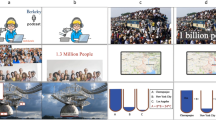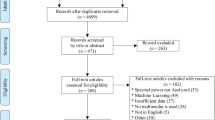Abstract
Educational multimedia has proven to be an effective and efficient way of learning. Designers strive to produce multimedia that convey concepts most efficiently. That is to design multimedia that imposes the least possible cognitive load on the learner. Mayer’s multimedia design principles are well-known, and multiple pieces of research have proven them to be effective. Reviewing the literature makes it obvious that there is a lack of a neurologically supported measure to express the effectiveness of these principles in the enhancement of the learning process. Mayer has reported the importance of these principles through effect sizes of scores obtained from transfer tests taken from the subjects. In this research, we utilized five of the twelve design principles introduced by Mayer to create With-Principles multimedia. These five principles were signaling, coherence, spatial contiguity, temporal contiguity and redundancy. We selected one chapter from Oxford’s open forum 3 and designed two versions of multimedia (With-Principles and Without-Principles) for the chapter. In one version, we designed the multimedia according to the design principles, and in the other version, no specific design principles were applied. A total number of 28 non-native English speaker students were divided into two groups. One group watched the With-Principles version of the multimedia, and the other group watched the Without-Principles version. NASA-TLX and a final comprehension test accompanied the procedure. Meanwhile, the subjects’ brain signals were being recorded. The results from both the post-task tests and the EEG analysis show that the With-Principles multimedia has imposed a significantly lower cognitive load on the learners. Furthermore, we propose the effectiveness of each principle by measuring the amount to which each principle has contributed to reducing the cognitive load of the subjects during the multimedia. Subjects’ brain signals analysis reveals that the signaling and the spatial contiguity principles have the most effect on learning enhancement.





Similar content being viewed by others
Explore related subjects
Discover the latest articles, news and stories from top researchers in related subjects.Data Availability
The datasets generated during and/or analyzed during the current study are available from the corresponding author on reasonable request.
Notes
Search for Extra-Terrestrial Life
Independent Component Analysis
Artifact Subspace Reconstruction
Power Spectral Density
Fast Fourier Transform
References
Anmarkrud, Ø., Andresen, A., & Bråten, I. (2019). Cognitive load and working memory in multimedia learning: Conceptual and measurement issues. Educational Psychologist, 54(2), 61–83.
Bigdely-Shamlo, N., Mullen, T., Kothe, C., Su, K.-M., & Robbins, K. A. (2015). The PREP pipeline: standardized preprocessing for large-scale EEG analysis. Frontiers in neuroinformatics, 9, 16.
Castro-Meneses, L. J., Kruger, J.-L., & Doherty, S. (2020). Validating theta power as an objective measure of cognitive load in educational video. Educational Technology Research and Development, 68(1), 181–202.
Cohen, J. (2013). Statistical power analysis for the behavioral sciences. Routledge.
Cohen, M. X. (2014). Analyzing neural time series data: theory and practice. MIT Press.
Debie, E., Rojas, R. F., Fidock, J., Barlow, M., Kasmarik, K., Anavatti, S., Garratt, M., & Abbass, H. A. (2021). Multimodal fusion for objective assessment of cognitive workload: A review. IEEE Transactions on Cybernetics, 51(3), 1542–1555. https://doi.org/10.1109/TCYB.2019.2939399
Delorme, A., & Makeig, S. (2004). EEGLAB: an open source toolbox for analysis of single-trial EEG dynamics including independent component analysis. Journal of neuroscience methods, 134(1), 9–21.
Fernandez Rojas, R., Debie, E., Fidock, J., Barlow, M., Kasmarik, K., Anavatti, S., Garratt, M., & Abbass, H. (2020). Electroencephalographic workload indicators during teleoperation of an unmanned aerial vehicle shepherding a swarm of unmanned ground vehicles in contested environments [Original Research]. Frontiers in Neuroscience, 14. https://doi.org/10.3389/fnins.2020.00040
Fink, A., & Benedek, M. (2014). EEG alpha power and creative ideation. Neuroscience & Biobehavioral Reviews, 44, 111–123.
Gerbaudo, R., Gaspar, R., & Gonçalves Lins, R. (2021). Novel online video model for learning information technology based on micro learning and multimedia micro content. Education and Information Technologies, 26(5), 5637–5665. https://doi.org/10.1007/s10639-021-10537-9
Hart, S. G., & Staveland, L. E. (1988). Development of NASA-TLX (Task Load Index): Results of empirical and theoretical research. In Advances in psychology (Vol. 52, pp. 139-183). Elsevier.
Herweg, N. A., Solomon, E. A., & Kahana, M. J. (2020). Theta oscillations in human memory. Trends in cognitive sciences, 24(3), 208–227.
Homan, R. W., Herman, J., & Purdy, P. (1987). Cerebral location of international 10–20 system electrode placement. Electroencephalography and clinical neurophysiology, 66(4), 376–382.
Jahng, J., Kralik, J. D., Hwang, D.-U., & Jeong, J. (2017). Neural dynamics of two players when using nonverbal cues to gauge intentions to cooperate during the Prisoner’s Dilemma Game. NeuroImage, 157, 263–274.
Jensen, O., Gelfand, J., Kounios, J., & Lisman, J. E. (2002). Oscillations in the alpha band (9–12 Hz) increase with memory load during retention in a short-term memory task. Cerebral cortex, 12(8), 877–882.
Karimi-Rouzbahani, H., Bagheri, N., & Ebrahimpour, R. (2017). Average activity, but not variability, is the dominant factor in the representation of object categories in the brain. Neuroscience, 346, 14–28.
Karimi-Rouzbahani, H., Bagheri, N., & Ebrahimpour, R. (2017). Hard-wired feed-forward visual mechanisms of the brain compensate for affine variations in object recognition. Neuroscience, 349, 48–63.
Khader, P. H., Jost, K., Ranganath, C., & Rösler, F. (2010). Theta and alpha oscillations during working-memory maintenance predict successful long-term memory encoding. Neuroscience Letters, 468(3), 339–343.
Klimesch, W. (2012). Alpha-band oscillations, attention, and controlled access to stored information. Trends in Cognitive Sciences, 16(12), 606–617.
Korbach, A., Brünken, R., & Park, B. (2018). Differentiating different types of cognitive load: A comparison of different measures. Educational Psychology Review, 30(2), 503–529.
Makransky, G., Terkildsen, T. S., & Mayer, R. E. (2019). Role of subjective and objective measures of cognitive processing during learning in explaining the spatial contiguity effect. Learning and Instruction, 61, 23–34. https://doi.org/10.1016/j.learninstruc.2018.12.001
Mayer, R. E. (2009). Multimedia learning (2nd ed.). Cambridge University Press. https://doi.org/10.1017/CBO9780511811678
Mayer, R. E. (2017). Using multimedia for e-learning. Journal of Computer Assisted Learning, 33(5), 403–423. https://doi.org/10.1111/jcal.12197
Miller, J., Watrous, A. J., Tsitsiklis, M., Lee, S. A., Sheth, S. A., Schevon, C. A., Smith, E. H., Sperling, M. R., Sharan, A., & Asadi-Pooya, A. A. (2018). Lateralized hippocampal oscillations underlie distinct aspects of human spatial memory and navigation. Nature Communications, 9(1), 1–12.
Naismith, L. M., Cheung, J. J., Ringsted, C., & Cavalcanti, R. B. (2015). Limitations of subjective cognitive load measures in simulation-based procedural training. Medical Education, 49(8), 805–814.
Narimani, M., & Soleymani, E. (2013). The effectivenes of cognitive rehabilitation on executive functions (working memory and attention) and academic achievement in students with math learning diworder. Journal of Learning Disabilities, 2(3), 91–115.
Paas, F. G. (1992). Training strategies for attaining transfer of problem-solving skill in statistics: a cognitive-load approach. Journal of Educational Psychology, 84(4), 429.
Paas, F., & Sweller, J. (2014). Implications of cognitive load theory for multimedia learning. The Cambridge Handbook of Multimedia Learning, 27, 27–42.
Paas, F., Tuovinen, J. E., Tabbers, H., & Van Gerven, P. W. (2003). Cognitive load measurement as a means to advance cognitive load theory. Educational Psychologist, 38(1), 63–71.
Paivio, A. (1990). Mental representations: A dual coding approach. Oxford University Press.
Pi, Z., Zhang, Y., Zhou, W., Xu, K., Chen, Y., Yang, J., & Zhao, Q. (2021). Learning by explaining to oneself and a peer enhances learners’ theta and alpha oscillations while watching video lectures. British Journal of Educational Technology, 52(2), 659–679.
Sanchiz, M., Lemarié, J., Chevalier, A., Cegarra, J., Paubel, P. V., Salmerón, L., & Amadieu, F. (2019). Investigating multimedia effects on concept map building: Impact on map quality, information processing and learning outcome. Education and Information Technologies, 24(6), 3645–3667. https://doi.org/10.1007/s10639-019-09943-x
Solomon, E. A., Lega, B. C., Sperling, M. R., & Kahana, M. J. (2019). Hippocampal theta codes for distances in semantic and temporal spaces. Proceedings of the National Academy of Sciences, 116(48), 24343–24352.
Sweller, J. (2011). CHAPTER TWO - cognitive load theory. In J. P. Mestre & B. H. Ross (Eds.), Psychology of learning and motivation (Vol. 55, pp. 37–76). Academic Press. https://doi.org/10.1016/B978-0-12-387691-1.00002-8
Sweller, J., van Merriënboer, J. J., & Paas, F. (2019). Cognitive architecture and instructional design: 20 years later. Educational Psychology Review, 31(2), 261–292.
Tenório, K., Pereira, E., Remigio, S., Costa, D., Oliveira, W., Dermeval, D., da Silva, A. P., Bittencourt, I. I., & Marques, L. B. (2022). Brain-imaging techniques in educational technologies: A systematic literature review. Education and Information Technologies, 27(1), 1183–1212. https://doi.org/10.1007/s10639-021-10608-x
Wang, S., Gwizdka, J., & Chaovalitwongse, W. A. (2016). Using Wireless EEG Signals to Assess Memory Workload in the $n$-Back Task. IEEE Transactions on Human-Machine Systems, 46(3), 424–435. https://doi.org/10.1109/THMS.2015.2476818
Wang, J., Antonenko, P., Keil, A., & Dawson, K. (2020). Converging subjective and psychophysiological measures of cognitive load to study the effects of instructor-present video. Mind, Brain, and Education, 14(3), 279–291.
Whitmarsh, S., Oostenveld, R., Almeida, R., & Lundqvist, D. (2017). Metacognition of attention during tactile discrimination. NeuroImage, 147, 121–129.
Acknowledgement
This work has been supported by Shahid Rajaee Teacher Training University.
Author information
Authors and Affiliations
Corresponding author
Ethics declarations
Ethical and Consent Statements
All subjects signed an informed written consent before attending the study. The experimental protocols were approved by the ethics committee of the Iran University of Medical Sciences. The Certificate of Approval Number is IR.IUMS.REC.1397.951.
Conflict of Interest
The authors declare that they have no conflict of interest.
Additional information
Publisher's Note
Springer Nature remains neutral with regard to jurisdictional claims in published maps and institutional affiliations.
Rights and permissions
Springer Nature or its licensor holds exclusive rights to this article under a publishing agreement with the author(s) or other rightsholder(s); author self-archiving of the accepted manuscript version of this article is solely governed by the terms of such publishing agreement and applicable law.
About this article
Cite this article
Farkish, A., Bosaghzadeh, A., Amiri, S.H. et al. Evaluating the Effects of Educational Multimedia Design Principles on Cognitive Load Using EEG Signal Analysis. Educ Inf Technol 28, 2827–2843 (2023). https://doi.org/10.1007/s10639-022-11283-2
Received:
Accepted:
Published:
Issue Date:
DOI: https://doi.org/10.1007/s10639-022-11283-2




